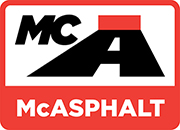Pothole Patching
Most pavements will require repairs such as potholes, utility cuts or traffic loading. The kinds of defects may vary from minor abrasions to major holes. Prompt repair can control expenditures and prolong the service life of a pavement. There are a number of different ways of producing the repair material needed.
Patching materials can be produced in a number of different ways:
Hot Mix Asphalt
Hot mix asphalt makes long-lasting patches that rapidly develop strength and stability. It should be used whenever it is practical and economical.
Cold Mix Asphalt
Cold mix asphalt can be produced different ways. The cold mix can be produced in a pugmill using asphalt emulsions (as discussed in stockpile maintenance mixes) or in a hot mix plant using either cutback asphalts or asphalt emulsions. In appearance they have the look of a conventional surface course hot mix except they are workable at ambient temperature. They are normally developed to have a minimum stockpile life of at least six months.
Special Proprietary Cold Mixes
The specialty mixes use proprietary liquids to produce the cold mix and can be made cold through a pugmill or warm through a hot mix plant. They tend to be made with a small one-sized aggregate and are designed to have a stockpile life of at least six months.
Design Criteria
The cold mix to be produced must be designed to meet the specification requirements of the client as well as any special requirements that the manufacturer of the cold mix liquid may have. The mix must meet the residual requirements as well as the gradation. The mix must meet the low temperature requirements for workability and cohesion as well the compatibility of the mix. The produced cold mix product no matter which type must withstand the stripping of the asphalt from the aggregate and remain well coated.
Materials
Asphalt Emulsions:
The emulsions used to make hot mixed cold mix can be either cationic or anionic. They can have very high residue (very little water) or like a conventional asphalt emulsion. They are designed with the proper solvents to ensure that the cold mix has low temperature workability and high temperature stability. They are used in the production of conventional cold mix. They have unique formulations which resists stripping and bleeding. Emulsions available are CCM5, ACM5, CCP3 and HF1000M. There are also polymer versions available.
Asphalt Cutback:
The cutback asphalt used for the cold mix patch process is SC800. The cold patch material is produced in a hot mix plant. The cold mix has the appearance of regular surface hot mix but has low temperature workability and cohesion. They are normally developed to have a minimum stockpile life of at least six months.
Specialty Asphalts:
The specialty asphalt used to produce the proprietary cold patch is especially designed and formulated to produce Perma Patch cold mix which is classified as a high performance cold mix. The finished liquid has a unique formulation which provides resistance to stripping, bleeding and gives excellent aggregate coating.
Aggregate:
The aggregates used to produce conventional cold mix are the same aggregates that are used to make hot mix. The cold mix is designed using these aggregates such that the mix stays workable and cohesive at cold temperatures. The aggregate used to produce the specialty cold mix is typically a ¼” limestone chip material that is 100% crushed.
Performance Guidelines
In order to construct a proper well designed cold mix the following guidelines should be followed:
- Determine which type of cold mix is going to be produced
- Determine which liquid product is going to be used; emulsion, cutback or specialty liquid
- Determine the aggregates to used
- Ensure compatibility of aggregate to the emulsion, cutback or specialty liquid
- Develop the proper mix design meeting all specification requirements
- Calibrate and inspect all equipment.
- Follow proper construction techniques and manufacturers recommendations
- Run quality control on finished product
- Work only in suitable weather
